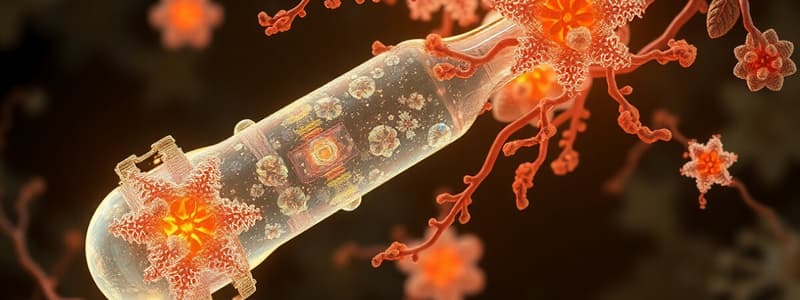Podcast
Questions and Answers
What is the definition of a pyrogen?
What is the definition of a pyrogen?
A pyrogen is a fever-producing substance.
Who is credited with establishing the microbiological origin of pyrogens?
Who is credited with establishing the microbiological origin of pyrogens?
Siebert, in 1923.
What is the relationship between pyrogens and bacterial endotoxins?
What is the relationship between pyrogens and bacterial endotoxins?
Pyrogens are considered to be identical or closely related to bacterial endotoxins.
What are the three main test methods used to detect pyrogens?
What are the three main test methods used to detect pyrogens?
What is the main purpose of the Monocyte Activation Test (MAT)?
What is the main purpose of the Monocyte Activation Test (MAT)?
Explain the mechanism of action of pyrogens in inducing fever.
Explain the mechanism of action of pyrogens in inducing fever.
What is the principle behind the LAL test?
What is the principle behind the LAL test?
Explain the principle behind the MAT.
Explain the principle behind the MAT.
What is the current trend in pyrogen testing in Europe?
What is the current trend in pyrogen testing in Europe?
Describe three methods for adding the endotoxin standard to a product dilution in the MAT.
Describe three methods for adding the endotoxin standard to a product dilution in the MAT.
Why is the MAT test considered a better alternative to the rabbit pyrogen test?
Why is the MAT test considered a better alternative to the rabbit pyrogen test?
Why is it necessary to confirm the absence of interfering factors in the MAT?
Why is it necessary to confirm the absence of interfering factors in the MAT?
What are the requirements for the standard curves used in the MAT?
What are the requirements for the standard curves used in the MAT?
Which test methodology is most reliable for detecting gram-positive bacteria as a source of pyrogens?
Which test methodology is most reliable for detecting gram-positive bacteria as a source of pyrogens?
What type of pyrogen is generally detected by the LAL test?
What type of pyrogen is generally detected by the LAL test?
What is the primary limitation of the Rabbit Pyrogen test in detecting pyrogens in cellular products?
What is the primary limitation of the Rabbit Pyrogen test in detecting pyrogens in cellular products?
Which test methodology is generally preferred for assessing the safety of pharmaceutical products?
Which test methodology is generally preferred for assessing the safety of pharmaceutical products?
Explain the concept of pyrogens and their potential impact in pharmaceutical and biological products.
Explain the concept of pyrogens and their potential impact in pharmaceutical and biological products.
Why is the Rabbit Pyrogen Test generally not preferred for assessing the safety of blood products?
Why is the Rabbit Pyrogen Test generally not preferred for assessing the safety of blood products?
What is the primary advantage of the LAL test in detecting bacterial endotoxins?
What is the primary advantage of the LAL test in detecting bacterial endotoxins?
Describe the rationale behind the use of the MAT test for assessing the safety of biological products, particularly recombinant therapeutic proteins.
Describe the rationale behind the use of the MAT test for assessing the safety of biological products, particularly recombinant therapeutic proteins.
Flashcards
Monocyte Activation Test (MAT)
Monocyte Activation Test (MAT)
A test to replace rabbit pyrogen tests, focusing on cytokine release.
Cytokines
Cytokines
Proteins released by monocytes in response to pyrogens, e.g., IL-6.
Endotoxin standard curve
Endotoxin standard curve
A graph used to determine the response of monocytes to various endotoxin levels.
Interfering factors
Interfering factors
Signup and view all the flashcards
Dilution methods in MAT
Dilution methods in MAT
Signup and view all the flashcards
Pyrogen
Pyrogen
Signup and view all the flashcards
Endotoxin
Endotoxin
Signup and view all the flashcards
Limulus Amoebocyte Lysate (LAL) test
Limulus Amoebocyte Lysate (LAL) test
Signup and view all the flashcards
Rabbit Pyrogen Test
Rabbit Pyrogen Test
Signup and view all the flashcards
Endogenous pyrogen
Endogenous pyrogen
Signup and view all the flashcards
Bacterial origin of pyrogens
Bacterial origin of pyrogens
Signup and view all the flashcards
Endotoxin Test (LAL)
Endotoxin Test (LAL)
Signup and view all the flashcards
MAT
MAT
Signup and view all the flashcards
Detectable Pyrogens
Detectable Pyrogens
Signup and view all the flashcards
Applications in Pharmaceuticals
Applications in Pharmaceuticals
Signup and view all the flashcards
Recombinant Therapeutic Proteins
Recombinant Therapeutic Proteins
Signup and view all the flashcards
Blood Products
Blood Products
Signup and view all the flashcards
Cellular Products
Cellular Products
Signup and view all the flashcards
Study Notes
Endotoxin and Pyrogen Testing
- Pyrogens are fever-producing substances, often of bacterial origin.
- In the early 20th century, their microbiological origins became understood, specifically linking them to filterable, thermostable substances from mainly Gram-negative bacteria.
- Pyrogens are now considered identical or closely related to bacterial endotoxins.
- Other substances, including some Gram-positive organisms, fungi, and viruses, can also trigger a pyrogenic response.
- Endogenous pyrogens (cytokines) are produced by host cells in response to exogenous pyrogens and then stimulate heat in the hypothalamus.
Pyrogen Test History
- The pyrogen test was introduced into the USP (United States Pharmacopeia) in 1942 and the British Pharmacopoeia in 1944.
- It involved observing the effect on rabbit rectal temperature when a test product was injected.
- The use of rabbit testing has declined, primarily due to the rise of the in vitro Limulus Amoebocyte Lysate (LAL) test.
Limulus Amoebocyte Lysate (LAL) Test
- The LAL test uses the lysis product of horseshoe crab amoebocytes.
- Presence of endotoxin in a sample causes a gel formation to occur.
- This test is used in place of the rabbit test, particularly for most current submissions.
Monocyte Activation Test (MAT)
- A newer test, the Monocyte Activation Test (MAT), is becoming a primary method to replace the rabbit test and, where required, the LAL test.
- The MAT is based on measuring the release of cytokines (e.g., IL-6, IL-1β) by monocytes in response to pyrogens.
- The MAT is required for new European submissions and is part of the 2012 FDA guidance.
- The European Commission aims to fully replace the rabbit test with the MAT test within five years.
Key Considerations for Pyrogen Testing
- Using the best possible testing method for the specific product and application.
- Ensuring test methods are accurate and properly validated.
- Confirmation that there are no interfering factors when testing.
Testing Methodologies
- Rabbit: Observed for effects on rectal temperature.
- LAL: Analyzes for the presence of endotoxin.
- MAT: Measures the release of pyrogen-induced cytokines from monocytes.
Table of Detectable Pyrogens and Applications (Page 2)
This table details the detection capabilities (plus/minus signs) of each method based on various pyrogen types and product classes. '+' indicates a generally reliable means of detection, '- 'indicates a method that may not effectively detect, and +/- indicates variable effectiveness.
Studying That Suits You
Use AI to generate personalized quizzes and flashcards to suit your learning preferences.



